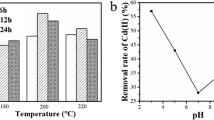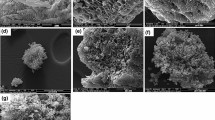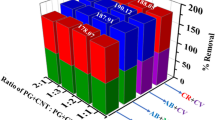Abstract
In this study, a carbon quantum dots composite was made from algal-cyanobacterial precursors using the oilothermal method. The performance of this composite as an adsorbent was evaluated in a model based on cadmium. The results showed that its optimal pH-dependent adsorption efficiency range is so broad that it covers pHs 5–10. The best correlations for adsorption isotherms and kinetics were observed with Langmuir and Elovich nonlinear models, respectively. The maximum cadmium adsorption capacity of 5.59882 ± 0.3276 mg/g and affinity constant of 2.66765 ± 0.56894 L/g were obtained in just 2 min of exposure time. The tolerance against ionic strength and co-existing cations was 5 ppm, and the recovery efficiency of cadmium from the natural sample was more than 95%. According to the findings of this research, it can be said that the algal-cyanobacterial origin carbon quantum dots composite, due to its unique properties, can be an efficient adsorbent for use in cadmium solid-phase extraction.
Graphical abstract













Similar content being viewed by others
Data availability
The datasets generated during the current study are available at: https://doi.org/10.6084/m9.figshare.20252625.
References
Ahmed M, Moerdijk-Poortvliet TC, Wijnholds A, Stal LJ, Hasnain S (2014) Isolation, characterization and localization of extracellular polymeric substances from the cyanobacterium Arthrospira platensis strain MMG-9. Eur J Phycol 49(2):143–150
Al-Maliky EA, Gzar HA, Al-Azawy MG (2021) Determination of point of zero charge (PZC) of concrete particles adsorbents. In: IOP conference series: materials science and engineering, vol 1184, no 1. IOP Publishing, p 012004
Arévalo-Gallegos A, Garcia-Perez JS, Carrillo-Nieves D, Ramirez-Mendoza RA, Iqbal HM, Parra-Saldívar R (2018) Botryococcus braunii as a bioreactor for the production of nanoparticles with antimicrobial potentialities. Int J Nanomed 13:5591–5604
Bakatula EN, Richard D, Neculita CM, Zagury GJ (2018) Determination of point of zero charge of natural organic materials. Environ Sci Pollut Res 25:7823–7833
Baldermann A, Grießbacher AC, Baldermann C, Purgstaller B, Letofsky-Papst I, Kaufhold S, Dietzel M (2018) Removal of barium, cobalt, strontium, and zinc from solution by natural and synthetic allophane adsorbents. Geosciences 8(9):309
Brown WH, Poon T, Poon T (2014) Introduction to organic chemistry, vol 7. Wiley, Hoboken, NJ
Camel V (2003) Solid phase extraction of trace elements. Spectrochim Acta Part B 58(7):1177–1233
de Carvalho JC, Sydney EB, Tessari LFA, Soccol CR (2019) Culture media for mass production of microalgae. In: Biofuels from algae. Elsevier, pp 33–50
Chen D, Hu B, Huang C (2009) Chitosan modified ordered mesoporous silica as micro-column packing materials for on-line flow injection-inductively coupled plasma optical emission spectrometry determination of trace heavy metals in environmental water samples. Talanta 78(2):491–497
Clark RL, McGinley LL, Purdy HM, Korosh TC, Reed JL, Root TW, Pfleger BF (2018) Light-optimized growth of cyanobacterial cultures: growth phases and productivity of biomass and secreted molecules in light-limited batch growth. Metab Eng 47:230–242
Cui L, Ren X, Sun M, Liu H, Xia L (2021) Carbon dots: synthesis, properties and applications. Nanomaterials 11(12):3419
Cytiva (n.d.) Cytopore 1 microcarriers (dry powder). https://www.cytivalifesciences.com/en/us/shop/cell-culture-and-fermentation/microcarriers/cytopore-1-microcarriers-dry-powder-p-05928. Accessed 8 Oct 2023
Das J, Velusamy P (2013) Antibacterial effects of biosynthesized silver nanoparticles using aqueous leaf extract of Rosmarinus officinalis L. Mater Res Bull 48(11):4531–4537
Decho AW, Gutierrez T (2017) Microbial extracellular polymeric substances (EPSs) in ocean systems. Front Microbiol 8:922
Delattre C, Pierre G, Laroche C, Michaud P (2016) Production, extraction and characterization of microalgal and cyanobacterial exopolysaccharides. Biotechnol Adv 34(7):1159–1179
Deruyck B, Nguyen TKH, Praveenkumar R, Muylaert K (2019) Low doses of the quaternary ammonium salt Cetyltrimethylammonium bromide can be used as a pesticide to control grazers in microalgal cultures. Algal Res 41:101570
Domozych DS, Stewart KD, Mattox KR (1980) The comparative aspects of cell wall chemistry in the green algae (Chlorophyta). J Mol Evol 15(1):1–12
Farid RK, Rahimi G (2022) Oilothermal, a novel pyrolysis method for fabrication of carbon dots-loaded carriers from cyanobacteria for use in solid-phase extraction of cadmium. J Taiwan Inst Chem Eng 132:104210
Fiol N, Villaescusa I (2009) Determination of sorbent point zero charge: usefulness in sorption studies. Environ Chem Lett 7:79–84
Genchi G, Sinicropi MS, Lauria G, Carocci A, Catalano A (2020) The effects of cadmium toxicity. Int J Environ Res Public Health 17(11):3782
Ghaedi M (2021) Adsorption: fundamental processes and applications. Academic Press, San Diego
Ghaedi M, Shokrollahi A, Niknam K, Niknam E, Najibi A, Soylak M (2009) Cloud point extraction and flame atomic absorption spectrometric determination of cadmium (II), lead (II), palladium (II) and silver (I) in environmental samples. J Hazard Mater 168(2–3):1022–1027
Godt J, Scheidig F, Grosse-Siestrup C, Esche V, Brandenburg P, Reich A, Groneberg DA (2006) The toxicity of cadmium and resulting hazards for human health. J Occup Med Toxicol 1(1):1–6
Guo S, Zhang F, Li D, Jiao P (2020) Highly efficient and selective removal of cadmium from aqueous solutions based on magnetic graphitic carbon nitride materials with molecularly imprinted polymers. J Mol Struct 1221:128887
Huang X, Qiao K, Li L, Liu G, Xu X, Lu R, Gao H, Xu D (2019) Preparation of a magnetic graphene/polydopamine nanocomposite for magnetic dispersive solid-phase extraction of benzoylurea insecticides in environmental water samples. Sci Rep 9(1):8919
Ismail MGBH, Weng CN, Rahman HA, Zakaria NA (2013) Freundlich isotherm equilibrium equations in determining effectiveness a low cost absorbent to heavy metal removal in wastewater (leachate) at Teluk Kitang Landfill, Pengkalan Chepa, Kelantan, Malaysia. J Geogr Earth Sci 1(1):1–8
Jahromi EZ, Bidari A, Assadi Y, Hosseini MRM, Jamali MR (2007) Dispersive liquid–liquid microextraction combined with graphite furnace atomic absorption spectrometry: ultra trace determination of cadmium in water samples. Anal Chim Acta 585(2):305–311
Jasim IA, Mahmood TS, Al-Mamoori SK, Al-Maliki LA (2021) The relationship between traffic congestion and land uses: a case study of Al-Kut city, Iraq. J Urban Regener Renew 14(3):264–271
Jelinek R (2017) Carbon quantum dots. Springer, Cham, pp 29–46
Kessler E (1980) Mass culture of Chlorella strains under conditions of high salinity, acidity, and temperature. Algol Stud/Arch Hydrobiol Suppl Vol 80–86
Kosmulski M (2009) Surface charging and points of zero charge, vol 145. CRC Press, Boca Raton
Kosmulski M (2020) The pH dependent surface charging and points of zero charge. VIII. Update. Adv Colloid Interface Sci 275:102064
Li S, Cai S, Hu W, Chen H, Liu H (2009) Ionic liquid-based ultrasound-assisted dispersive liquid–liquid microextraction combined with electrothermal atomic absorption spectrometry for a sensitive determination of cadmium in water samples. Spectrochim Acta Part B 64(7):666–671
Li YK, Yang T, Chen ML, Wang JH (2018) Supported carbon dots serve as high-performance adsorbent for the retention of trace cadmium. Talanta 180:18–24
Lürling M, Eshetu F, Faassen EJ, Kosten S, Huszar VL (2013) Comparison of cyanobacterial and green algal growth rates at different temperatures. Freshw Biol 58(3):552–559
Maynardo JJ, Doshi VEENA, Rajanren JR, Rajasekaran R (2015) The optimization of light intensity and drying temperature on lipid content of microalgae Nannochloropsis oculata. J Eng Sci Technol 1:112–121
Melek E, Tuzen M, Soylak M (2006) Flame atomic absorption spectrometric determination of cadmium (II) and lead (II) after their solid phase extraction as dibenzyldithiocarbamate chelates on Dowex Optipore V-493. Anal Chim Acta 578(2):213–219
Morales-Torres S, Pérez-Cadenas AF, Carrasco-Marín F (2020) Element-doped functional carbon-based materials. Materials 13(2):333
Park E, Kim S, Song SH, Lee CW, Kwon JT, Lim MK, Park EY, Won YJ, Jung KW, Kim B (2021) Environmental exposure to cadmium and risk of thyroid cancer from national industrial complex areas: a population-based cohort study. Chemosphere 268:128819
Piorreck M, Baasch KH, Pohl P (1984) Biomass production, total protein, chlorophylls, lipids and fatty acids of freshwater green and blue-green algae under different nitrogen regimes. Phytochemistry 23(2):207–216
Pollet M, Daturi M, Marinel S (2004) Vibrational spectroscopy study of the lattice defects in CaZrO3 ceramics. J Eur Ceram Soc 24(6):1805–1809
Pyrzynska K (2019) Removal of cadmium from wastewaters with low-cost adsorbents. J Environ Chem Eng 7(1):102795
Rahman A, Kumar S, Bafana A, Dahoumane SA, Jeffryes C (2019) Individual and combined effects of extracellular polymeric substances and whole cell components of Chlamydomonas reinhardtii on silver nanoparticle synthesis and stability. Molecules 24(5):956
Rao MD, Pennathur G (2017) Green synthesis and characterization of cadmium sulphide nanoparticles from Chlamydomonas reinhardtii and their application as photocatalysts. Mater Res Bull 85:64–73
Rao TP, Daniel S, Gladis JM (2004) Tailored materials for preconcentration or separation of metals by ion-imprinted polymers for solid-phase extraction (IIP-SPE). TrAC Trends Anal Chem 23(1):28–35
Singh AK (2016) Nanoparticle ecotoxicology. In: Engineered nanoparticles, pp 343–450
Singh S, Kant C, Yadav RK, Reddy YP, Abraham G (2019) Cyanobacterial exopolysaccharides: composition, biosynthesis, and biotechnological applications. In: Cyanobacteria. Academic Press, pp 347–358
Sixsmith D (1977) The effect of compression on some physical properties of microcrystalline cellulose powders. J Pharm Pharmacol 29(1):33–36
Sparks DL (2003) Environmental soil chemistry: an overview. Environ Soil Chem 2:1–42
Suhani I, Sahab S, Srivastava V, Singh RP (2021) Impact of cadmium pollution on food safety and human health. Curr Opin Toxicol 27:1–7
Syauqiah I, Nurandini D, Prihatini NS, Simanjuntak RA, 2021. Effect of stirring speed on cadmium (Cd) metal adsorption from Sasirangan liquid waste by rice husk activated carbon. Konversi 10(1)
Tinkov AA, Gritsenko VA, Skalnaya MG, Cherkasov SV, Aaseth J, Skalny AV (2018) Gut as a target for cadmium toxicity. Environ Pollut 235:429–434
Tsavatopoulou VD, Aravantinou AF, Vakros J, Manariotis ID (2021) Conversion of Scenedesmus rubescens lipid into biodiesel by biochar of different origin. Catalysts 11(9):1116
Tuerhong M, Yang XU, Xue-Bo YIN (2017) Review on carbon dots and their applications. Chin J Anal Chem 45(1):139–150
Tuzen M, Saygi KO, Soylak M (2008) Solid phase extraction of heavy metal ions in environmental samples on multiwalled carbon nanotubes. J Hazard Mater 152(2):632–639
Vamanu E, Ene M, Biță B, Ionescu C, Crăciun L, Sârbu I (2018) In vitro human microbiota response to exposure to silver nanoparticles biosynthesized with mushroom extract. Nutrients 10(5):607
Wang Z, Xu W, Jie F, Zhao Z, Zhou K, Liu H (2021) The selective adsorption performance and mechanism of multiwall magnetic carbon nanotubes for heavy metals in wastewater. Sci Rep 11(1):16878
Xu X, Ray R, Gu Y, Ploehn HJ, Gearheart L, Raker K, Scrivens WA (2004) Electrophoretic analysis and purification of fluorescent single-walled carbon nanotube fragments. J Am Chem Soc 126(40):12736–12737
Xu Q, Ge K, Zhang S, Tan B (2021) Understanding the adsorption and inhibitive properties of nitrogen-doped carbon dots for copper in 0.5 M H2SO4 solution. J Taiwan Inst Chem Eng 125:23–34
Yanagimoto M, Saitoh H (1982) Evaluation tests of a large spiral blue green alga, Oscillatoria sp., for biomass production. J Ferment Technol 60(4):305–310
Yang T, Li YK, Chen ML, Wang JH (2015) Supported carbon dots decorated with metallothionein for selective cadmium adsorption and removal. Chin Chem Lett 26(12):1496–1501
Yang T, He R, Nie G, Wang W, Zhang G, Hu Y, Wu L (2018) Creation of hollow calcite single crystals with CQDs: synthesis, characterization, and fast and efficient decontamination of Cd (II). Sci Rep 8(1):17603
Yang PC, Ting YX, Gu S, Gandomi YA, Hsieh CT (2021) Fluorescent nitrogen-doped carbon nanodots synthesized through a hydrothermal method with different isomers. J Taiwan Inst Chem Eng 123:302–309
Yuan C, Li Q, Sun Z, Sun H (2021) Effects of natural organic matter on cadmium mobility in paddy soil: a review. J Environ Sci 104:204–215
Zhang QH, Zhou LD, Chen H, Wang CZ, Xia ZN, Yuan CS (2016) Solid-phase microextraction technology for in vitro and in vivo metabolite analysis. TrAC Trends Anal Chem 80:57–65
Zhang X, Sun C, Zhang L, Liu H, Cao B, Liu L, Gong W (2018) Adsorption studies of cadmium onto magnetic Fe3O4@ FePO4 and its preconcentration with detection by electrothermal atomic absorption spectrometry. Talanta 181:352–358
Zhao X, Shi Y, Wang T, Cai Y, Jiang G (2008) Preparation of silica-magnetite nanoparticle mixed hemimicelle sorbents for extraction of several typical phenolic compounds from environmental water samples. J Chromatogr A 1188(2):140–147
Zhao H, Huang X, Liu F, Hu X, Zhao X, Wang L, Gao P, Li J, Ji P (2021) Potential of a novel modified gangue amendment to reduce cadmium uptake in lettuce (Lactuca sativa L.). J Hazard Mater 410:124543
Acknowledgements
This work is based upon research funded by Iran National Science Foundation (INSF) under Project No 99026873.
Funding
Tahereh Mohammadi Arian reports financial support that was provided by Iran National Science Foundation.
Author information
Authors and Affiliations
Contributions
All authors have contributed to all stages of the study.
Corresponding author
Ethics declarations
Conflict of interest
The authors declare the following financial interests/personal relationships which may be considered as potential competing interests:
Additional information
Editorial responsibility: Parveen Fatemeh Rupani.
Supplementary Information
Below is the link to the electronic supplementary material.
Rights and permissions
Springer Nature or its licensor (e.g. a society or other partner) holds exclusive rights to this article under a publishing agreement with the author(s) or other rightsholder(s); author self-archiving of the accepted manuscript version of this article is solely governed by the terms of such publishing agreement and applicable law.
About this article
Cite this article
Mohammadi Arian, T., Khavari Farid, R., Rahimi, G. et al. Fabrication of carbon quantum dots composite from algal-cyanobacterial precursor using oilothermal method for heavy metal preconcentration. Int. J. Environ. Sci. Technol. 21, 2407–2432 (2024). https://doi.org/10.1007/s13762-023-05353-2
Received:
Revised:
Accepted:
Published:
Issue Date:
DOI: https://doi.org/10.1007/s13762-023-05353-2




